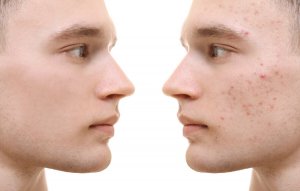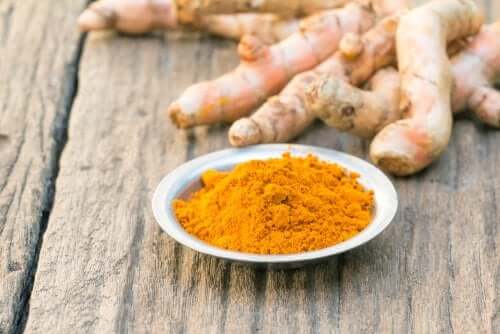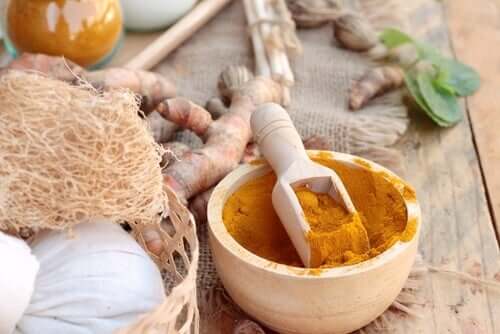How to Use Turmeric to Treat Acne

For many years, turmeric has been valued for its medicinal and cosmetic uses. While it’s normally used as a culinary ingredient, many people prefer to use it for its curative effects. Did you know that you can use turmeric to treat acne? Today we’ll tell you how.
Turmeric has a biologically active compound called curcumin, which gives it its characteristic color and a large part of its properties. This substance acts as an anti-inflammatory and antioxidant, making it useful both internally and topically.
So, it’s not surprising that its extracts are used in dermatology. Although research about its properties continues, it’s currently accepted as a natural remedy for problems like acne. Try it out!
Why use turmeric to treat acne?

There are various and interesting benefits of using turmeric to treat acne. First, it’s important to highlight its antibacterial properties capable of fighting microorganisms like P. acnes when combined with lauric acid. Its effect is comparable to pharmaceuticals like erythromycin and clindamycin.
On the other hand, this marvelous spice has anti-inflammatory effects that positively affect dermatological problems. Although we need more scientific evidence to verify its effect on acne, anecdotal evidence suggests that it’s effective.
Turmeric and its antioxidants also have other important effects when it comes to treating acne. Applying it topically helps repair tissue, minimizing the presence of scars. Likewise, it stimulates the production of collagen and reduces the risk of premature wrinkles.
Other benefits of turmeric for the skin
Unlike other more conventional treatments, using turmeric for acne has other important effects on your skin’s health. Thanks to the curcumin, vitamins, and minerals it contains, it’s a good enhancement for your skin health. Among other benefits, turmeric:
- Contributes to, and increases, your skin’s natural glow
- Promotes healing of wounds
- Helps confront psoriasis flare-ups
- Helps treat scabies
- Minimizes oxidative stress and prevents premature aging
Turmeric treatment for acne

To take full advantage of the properties of turmeric for treating acne, we propose a treatment in which we amplify its effect by using the components of coconut oil. This natural ingredient contains lauric acid, recognized for its antimicrobial effect, and useful for treating acne.
In addition, coconut oil has been widely studied in dermatology, since it hydrates the skin and helps treat illnesses like psoriasis and eczema. Like turmeric, it even helps the process of scarring and regeneration, minimizing the negative effects of free radicals.
Ingredients
- 1 tablespoon of ground turmeric (15 g)
- 2 tablespoons of organic coconut oil (30 g)
- 1 tablespoon of honey (15 g)
Preparation
- First, pour the ground turmeric into a clean container
- Then, add the coconut oil and honey
- Finally, stir for a few minutes until you get a homogeneous mixture
How to use it
- Before applying the mask on the areas of skin affected by acne, it’s important that you get rid of any makeup residue or dirt
- Once your face is clean, you can start to apply the mask
- Make sure you completely cover the problem areas
- Let it sit for 15 minutes and then rinse with warm water
- Repeat these steps and apply at least 3 times per week
Note: the results won’t be visible immediately. It’s important to use this remedy consistently to achieve the desired results.
Don’t miss out on: Fight Acne by Adding these 5 Detox Smoothies to Your Diet
Warnings
Although this turmeric treatment can be very effective at removing acne, you should be aware that it can cause side effects. When you apply it topically it can temporarily stain the skin or leave a light, yellow residue. This usually disappears with a good cleaning.
However, sometimes the components can cause allergic reactions or contact dermatitis. A review carried out in 2015 found that curcumin is an allergen and can cause irritation, redness, and swelling in people who are allergic.
Due to the above, it’s best to do a small test before putting on the whole acne treatment. All you need to do is put a bit of turmeric on your forearm or another part of your skin. If, after 24 hours, there aren’t any negative reactions, then it’s safe to use.
In summary…
Turmeric can be a great ally in the fight against acne, especially when you combine it with coconut oil. You should use it with caution, since it can cause an allergic reaction in some people. For everyone else, it’s a great option to support other conventional treatments to remove acne.
All cited sources were thoroughly reviewed by our team to ensure their quality, reliability, currency, and validity. The bibliography of this article was considered reliable and of academic or scientific accuracy.
- Liu, C.-H., & Huang, H.-Y. (2013). In Vitro Anti-Propionibacterium Activity by Curcumin Containing Vesicle System. Chemical and Pharmaceutical Bulletin. https://doi.org/10.1248/cpb.c12-01043
- Gupta, S. C., Kismali, G., & Aggarwal, B. B. (2013). Curcumin, a component of turmeric: From farm to pharmacy. BioFactors. https://doi.org/10.1002/biof.1079
- Akbik, D., Ghadiri, M., Chrzanowski, W., & Rohanizadeh, R. (2014). Curcumin as a wound healing agent. Life Sciences. https://doi.org/10.1016/j.lfs.2014.08.016
- Thangapazham, R. L., Sharad, S., & Maheshwari, R. K. (2013). Skin regenerative potentials of curcumin. BioFactors. https://doi.org/10.1002/biof.1078
- Thangapazham, R. L., Sharma, A., & Maheshwari, R. K. (2007). Beneficial role of curcumin in skin diseases. Advances in Experimental Medicine and Biology. https://doi.org/10.1007/978-0-387-46401-5_15
- Ferreira, L. A. M., Alves, R. J., Carneiro, G., Silva, E. L., Trindade, V., de Carvalho, M. A. R., … Goulart, C. (2014). Solid Lipid Nanoparticles Loaded with Retinoic Acid and Lauric Acid as an Alternative for Topical Treatment of Acne Vulgaris. Journal of Nanoscience and Nanotechnology. https://doi.org/10.1166/jnn.2015.9184
- Chaudhari, S. P., Tam, A. Y., Barr, J. A., & Tan, J. (2015). Curcumin: A contact allergen. Journal of Clinical and Aesthetic Dermatology.
This text is provided for informational purposes only and does not replace consultation with a professional. If in doubt, consult your specialist.








